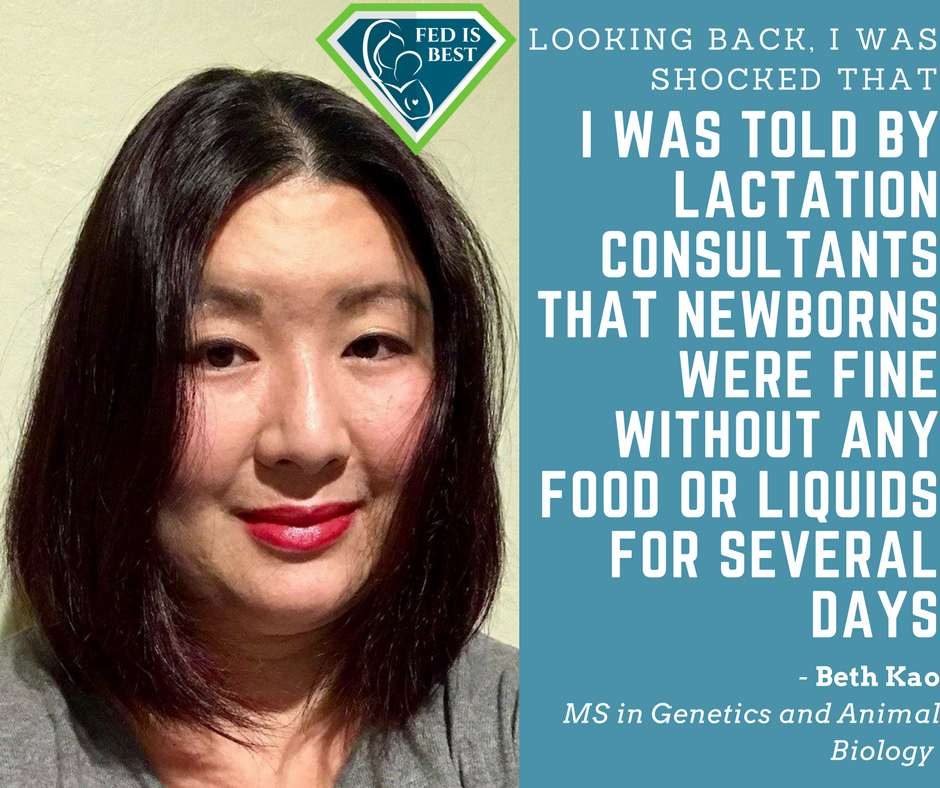By Beth Kao, Fed is Best Mom and Advocate
When I finally got pregnant via IVF with my son Ike, I decided that I wanted to breastfeed him. Why? Immunological benefits, possible lower obesity and diabetes risk, possibly smarter… As a scientist, I didn’t quite buy the higher IQ selling points of breastfeeding, but the immunological benefits seemed plausible to me. My two siblings, who seemed to have far fewer instances of illness and health issues, were breastfed while I was exclusively formula fed, so anecdotally, it seemed that breastfeeding made a positive impact on health. I delivered my son at a hospital that was touted to have one of the best birth centers in the Bay Area. One of the key takeaways from the birth center tour was that breastfeeding was specifically embraced and emphasized, so I put on my birth plan that I planned to breastfeed.
Labor and delivery was difficult. After 27 hours of labor, nearly 4 hours of pushing, and a failed vacuum extraction, Baby Ike was delivered via C-section. When the nurse handed Ike to me to breastfeed him, he would not latch, but would push me away and scream like I was trying to murder him–and this would happen each time I tried to breastfeed him. Despite this, the nurses had me adhere to a breastfeeding schedule every 2 hours (because, they reminded me, my birth plan stated that I wanted to breastfeed). Each time the nurse or my husband handed Ike to me to breastfeed, I was filled with dread. I fought the urge to break down into tears as Ike pushed me away and arched his back while screaming as I tried to coax him into latching onto my breast.
“I think our baby hates me,” I said to my husband after the umpteenth failed breastfeeding attempt.
My milk did not come in while I was in the hospital recovering, and did not come in until 9 days post-partum. Since my baby wasn’t latching, a breast pump was delivered to my room to help stimulate milk production. I was not given instructions on how to use the pump and I used the wrong size flange and made the mistake of turning the suction power all the way to the highest level. I also was pumping dry breasts for over 45 minutes which led to sore, cracked nipples and not a drop of milk! So I hand expressed as much colostrum into a 1 cc syringe and fed my newborn whatever I could squeeze out of my breasts.
Postpartum depression and anxiety crept up on me while I was in the hospital recovering from the C-section, although I didn’t realize what was happening at the time. Being confined to a hospital bed after the C-section, with a catheter inserted, an attached BP cuff intermittently squeezing my arm, and sequential compression devices squeezing my legs exacerbated my claustrophobia, and I found myself frequently fighting off panic attacks. I resisted sleeping and would lie awake gripped in fear and anxiety about my baby. The two hour feeding intervals had me constantly watching the clock with apprehension.
During my recovery at the hospital, I had 4 brief visits by 4 different lactation consultants (IBCLCs). They were all very lovely and nice ladies, but some of their suggestions and advice conflicted with each other. Little to no progress was made with breastfeeding after their visits.
“Use a nipple shield to help with latching.”
“Don’t use a nipple shield! It will negatively impact your supply. It may lead to nipple confusion and you’ll have a hard time weaning the baby off of the nipple shield later.”
“Try the football hold. It is the best hold for C-section moms.”
“Try ‘biological nursing!’ Let gravity assist the baby in the latching.’”
“Try SNS so that the baby will stimulate your body to produce milk.”
Coping with pain from a major abdominal surgery, sleep deprivation, excruciating nipple pain, postpartum depression, and severe anxiety regarding breastfeeding made it difficult to absorb the information given to me by the IBCLCs.
At 48 hours postpartum, my son had lost 11% of his body weight and had a touch of jaundice. I was struck with guilt that I allowed my child to go without nutrients/fluids for two days. A LC reassured me that babies were built withstand no fluids for that long–even longer! So instead of simply giving my son formula in a bottle, it was suggested that we try SNS along with a nipple shield, which was an arduous 2 person job to set up each time. After the usual bout of screaming and fighting, my son would finally latch onto the nipple shield and only take about 5-10 cc of formula through the SNS at each feeding and continued to lose weight. At day 3, the pediatrician ordered formula to get baby’s weight back up. I felt both relief and tremendous guilt–relief that Ike was finally fed, and guilt for failing my son.
Ike starved for 2 days and I let it happen. My failure to breastfeed my child compounded my postpartum depression.
We were released from the hospital with a small supply of formula, a couple of nipple shields, the SNS, but still with no clue on how to breastfeed. I’m not sure why, but I still wanted to try breastfeeding Ike despite all of the anxiety associated with breastfeeding. So we continued to seek out assistance from additional LCs. The 5th LC that we consulted put me on a breastfeeding-followed-by-pumping every 2 hours regimen, no formula supplementation allowed. This was the only way to establish breastfeeding and increase my supply, and formula supplementation would derail the establishment of my milk supply, she explained. She suggested a follow-up appointment 3 days later to weigh the baby and to make sure I was following the regimen. She also recommended that the baby see an osteopath, since the birth was “traumatic” and likely “tweaked his body out of alignment.”
An osteopath was supposed to put Ike’s body back into alignment, which would facilitate better latching. Looking back, I don’t know why I agreed to such a thing, especially being a scientist, but I was desperate to try anything. The osteopath put her hands on Ike, closed her eyes, and breathed deeply… Oh, and she used this strange looking vibrating device that looked like something you’d use to wax and buff a car on Ike’s body. For that, we were charged $240 (private pay) per session. We did two sessions before I decided that it was too ridiculous and expensive to continue.
Things finally started to turn around when we consulted a 6th LC, Sheridan Ross. We still weren’t able to get baby to latch without a nipple shield during the first consult (more screaming and back arching), but she left me with a wonderful multi-page care/action plan full of great information and resources (how to align the baby with the breast, how to assist latching with the “breast sandwich,” how to properly use a pump, baby sleeping patterns and growth spurts). In her care/action plan, Sheridan suggested that I attempt getting Ike to latch twice a day as a starting point and work from there, and only attempt latching when Ike and I were both feeling calm. She didn’t want breastfeeding to be associated with a traumatic event for either of us. I think Sheridan was the only LC that really recognized my PPD, while the other LCs really only focused on Ike and my milk production. Sheridan saw that I was at a tipping point with the depression, anxiety, post-C-section pain, and lack of sleep.
The most important part of her approach in helping me was that she didn’t take an “all-or-nothing” attitude to breastfeeding: She didn’t tell me that I should avoid formula at all costs. She didn’t tell me that using a nipple shield would doom my breastfeeding relationship. She didn’t push a strict 2 hour feeding-pumping regimen that could have broken me as a mother with PPD.
At 3 weeks postpartum, I was finally able to successfully establish a breastfeeding relationship with Ike (sans nipple shield!). Because of Sheridan’s balanced and gentle approach to breastfeeding, I finally came to see my breastfeeding relationship with Ike as a positive one, and I breastfed Ike to 33 months. In those 33 months, I had to supplement with formula every now and then, but I no longer saw formula supplementation as a failure.

We’ve created a feeding plan template to assist you in setting goals for your little one, by understanding your baby’s needs based on their birth statistics and what options you have (but may not know to ask).
Some of the information needed will be available to you by asking your healthcare provider directly, or requesting that they fill out your newborn’s data at birth.
Using this guide, you will be able to judge how best to hit your feeding targets, and be able to clearly inform your medical team what you would like to do if problems arise during the course of feeding. Downloadable and Free Infant Feeding Plan
Do you need support, have a story you want to share or want to volunteer with our Foundation team? Please contact us: Contact us
Are you a health care professional who wants to connect with other practicing providers and nurses? We have a private group of health care professionals that are working together and welcome you to join. Please contact us: Contact us
Can you help support our grass roots movement by donating to our Foundation? Donate

